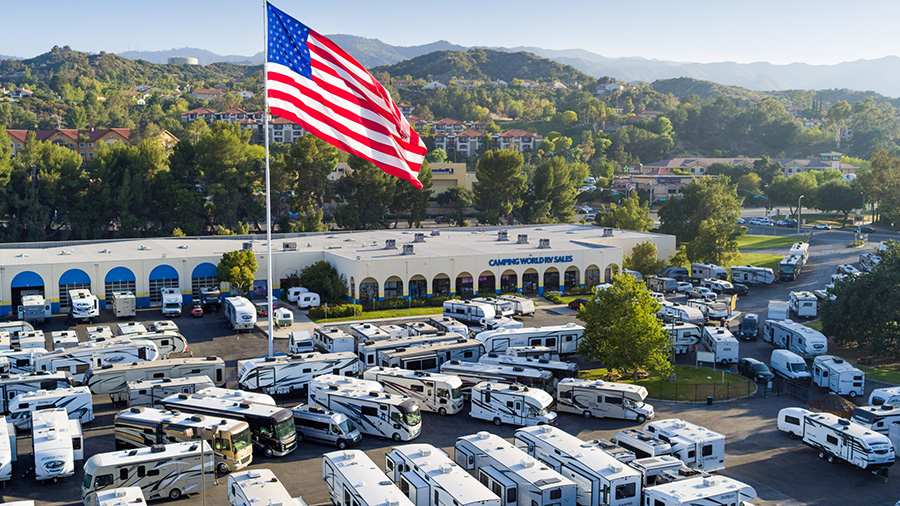Camping World Holdings, Inc. (CWH) saw shares sharply lower on Thursday, July 30, after the company missed second-quarter earnings per share by a penny while beating analyst forecasts on the top line. Stock Story suggested that investors appeared to focus on the earnings shortfall, and the negative sentiment was likely compounded by analyst projections that suggested future revenue growth would decelerate amid potential demand headwinds.
Still, company Chairman and CEO Marcus Lemonis said he was “unbelievably pleased” with the company’s financial performance in the quarter, which he attributed to volume, margin performance, and aggressive cost controls.
“We continue to surgically manage our inventory to find volume and gross profit opportunities, leveraging our new and used supply chains, our contract manufacturing relationships, our sophisticated data analytics, and the strength of our balance sheet to put the right inventory on the ground at the right time and the right price. Our nimbleness is a true testament to the differentiation and durability of our model,” Lemonis offered.
Investors did not necessarily agree with his sentiment, as CWH shares fell by more than 15 percent on Thursday, July 31.
Lemonis went on to say that CWH made structural changes to fixed costs compared to last year, reducing headcount by over 900 people, consolidating 16 locations, and selling 7,818 more units. He said this had meaningfully improved per-rooftop productivity and proved the company could adapt to the near-term ASP contribution margin environment in new vehicles.
Revenue was reported at $2.0 billion for the second quarter, an increase of $169.4 million, or 9.4 percent.
- New vehicle revenue was $915.1 million for the quarter, an increase of $68.0 million, or 8.0 percent, year-over-year (y/y) and new vehicle unit sales were 26,696 units, an increase of 4,612 units, or 20.9 percent growth y/y.
- Used vehicle revenue was $572.3 million for the second quarter, an increase of $91.5 million, or 19.0 percent, y/y and used vehicle unit sales were 18,906 units, an increase of 3,206 units, or up 20.4 percent y/y.
- Combined new and used vehicle unit sales were 45,602, an increase of 7,818 units, or 20.7 percent growth y/y.
- Average selling price of new vehicles sold decreased 10.6 percent and average selling price of used vehicles sold decreased 1.2 percent.
- Same-store new vehicle unit sales increased 22.2 percent y/y for the second quarter and same-store used vehicle unit sales increased 20.8 percent year/y. Combined same-store new and used vehicle unit sales increased 21.6 percent y/y.
- Products, service and other revenue was $222.9 million, a decrease of 5.5 percent y/y, driven primarily by a reallocation of service labor toward used inventory reconditioning and the divestiture of the RV furniture business in May 2024.
“Our same-store unit growth trends July month-to-date are tracking up high-teens percent on used vehicles and up high-singles on new vehicles compared to the prior year, both in line on a multi-year basis with our second quarter performance,” commented CWH President Matthew Wagner. “Our guideposts for the full year remain largely unchanged, although our new unit volume is now expected to be higher, growing in excess of high-singles compared to the prior year. New vehicle ASP is expected to improve seasonally in the third and fourth quarter but could be lower by 10-12 percent for the full year compared to the prior year. Despite this drop in ASP we are expecting to accomplish 300-400 basis points of improvement in SG&A as a percentage of gross profit, recognizing that this efficiency will improve further as ASPs rebound.”
Profitability and Expenses
Gross profit was $592.3 million, an increase 8.1 percent y/y, and total gross margin was 30.0 percent of sales, a decrease of 34 basis points y/y. The gross profit increase was said to be mainly driven by the $25.9 million higher used vehicle gross profit from the increase in used vehicle unit sales and gross margin and $22.2 million increased finance and insurance, net (F&I) gross profit largely from the 20.7 percent increase in combined new and used vehicle unit sales and new F&I offerings. The consolidated gross margin decrease was said to be primarily from higher roadside assistance claim costs that drove the 777 basis point decrease in Good Sam Services and Plans gross margin to 59.5 percent, which was mostly offset by improvements for used vehicles and products, service and other discussed above.
- New vehicle gross margin was 13.8 percent of sales, a decrease of 149 basis points y/y, reportedly driven primarily by the 10.6 percent decrease in the average selling price per new vehicle sold, partially offset by a 9.1 percent reduction in the average cost per new vehicle sold.
- Used vehicle gross margin was 20.5 percent of sales, an increase of 149 basis points y/y, said to be primarily due to a 3.0 percent decrease in the average cost per unit sold, partially offset by the 1.2 percent lower average selling price.
Products, service and other gross margin was 47.8 percent, an increase of 411 basis points y/y, reportedly driven by the divestiture of the RV furniture business, which had negative gross margins for the three months ended June 30, 2024, and increased sales volume of our higher-margin aftermarket part assortment.
Selling, general and administrative expenses (SG&A) were $437.5 million in Q2, an increase of $17.8 million, or 4.2 percent y/y. This increase was said to be primarily driven by a $7.5 million increase in employee cash compensation costs, a $3.0 million increase in employee stock-based compensation expense, $2.9 million of additional advertising expenses, and an additional $3.3 million for other outside service providers.
- SG&A excluding stock-based compensation expense was $429.1 million, an increase of 3.6 percent y/y.
Floor plan interest expense was $21.0 million, a decrease of $6.8 million, or 24.5 percent, as a result of lower interest rates and lower principal balances. Other interest expense, net was $30.8 million, a decrease of $5.3 million, or 14.7 percent, as a result of lower interest rates and, to a lesser extent, lower principal balances.
Net income was $57.5 million for the second quarter of 2025, an improvement of $34.1 million, or 145.7 percent y/y.
Adjusted EBITDA was $142.2 million, an increase of $36.6 million, or 34.7 percent y/y.
Diluted earnings per share of Class A common stock was 48 cents, an improvement of 26 cents per share y/y.
- Adjusted diluted earnings per share of Class A common stock was 57 cents, an improvement of 19 cents year-over-year.
The total number of store locations was 201 as of June 30, 2025, a net decrease of 14 store locations from June 30, 2024, which included the consolidation of 16 store locations to improve the overall cost efficiency of the remaining store locations.
Company CFO Tom Kirn said CWH expects cash flow to benefit from the passage of the One Big Beautiful Bill Act through the immediate deductibility of floorplan interest expense on travel trailers and fifth wheels.
“We estimate annual cash tax savings of $15 to $20 million in 2025 and expect to prioritize debt paydown and deleveraging activities with those savings. Including payments in July 2025, we’ve paid down debt by over $75 million in total since October of last year,” he noted.
“We enter the second half more confident than ever in our mid-cycle earnings power scenario of over $500 million of adjusted EBITDA based on today’s store count, particularly as the company’s per rooftop productivity accelerates, resulting in better earnings, better leverage, and a greater willingness to explore new market expansion opportunities,” Lemonis concluded. “Given results year-to-date, we believe that more upside exists in the 15 percent new and used combined market share goal we set last year, with 20 percent plus emerging as a realistic medium-term goal. The team also set an internal mandate to accelerate gross margin by 100 basis points, further bolstering our confidence in the earnings power of our business model.”
Revisions to Prior Period Condensed Consolidated Financial Statements
Subsequent to the issuance of the company’s condensed consolidated financial statements for the three and six months ended June 30, 2024, the company’s management identified prior-period misstatements related to the measurement of the realizable portion of the Company’s outside basis difference deferred tax asset in CWGS Enterprises, LLC, including the associated valuation allowance. As a result, deferred tax assets, net, additional paid-in capital, and income tax benefit (expense) as of and for the years ended December 31, 2023, and 2022 were revised in the company’s Annual Report on Form 10-K for the year ended December 31, 2024, filed with the SEC on February 28, 2025. The misstatements impacted the beginning balances of deferred taxes, net, additional paid-in capital, and retained earnings, which have been revised from the amounts previously reported as of June 30, 2024.
The company stated that it evaluated the materiality of these errors, both qualitatively and quantitatively, and determined that the effect of these revisions was not material to the previously issued financial statements.
Image courtesy Camping World Holdings, Inc.
















